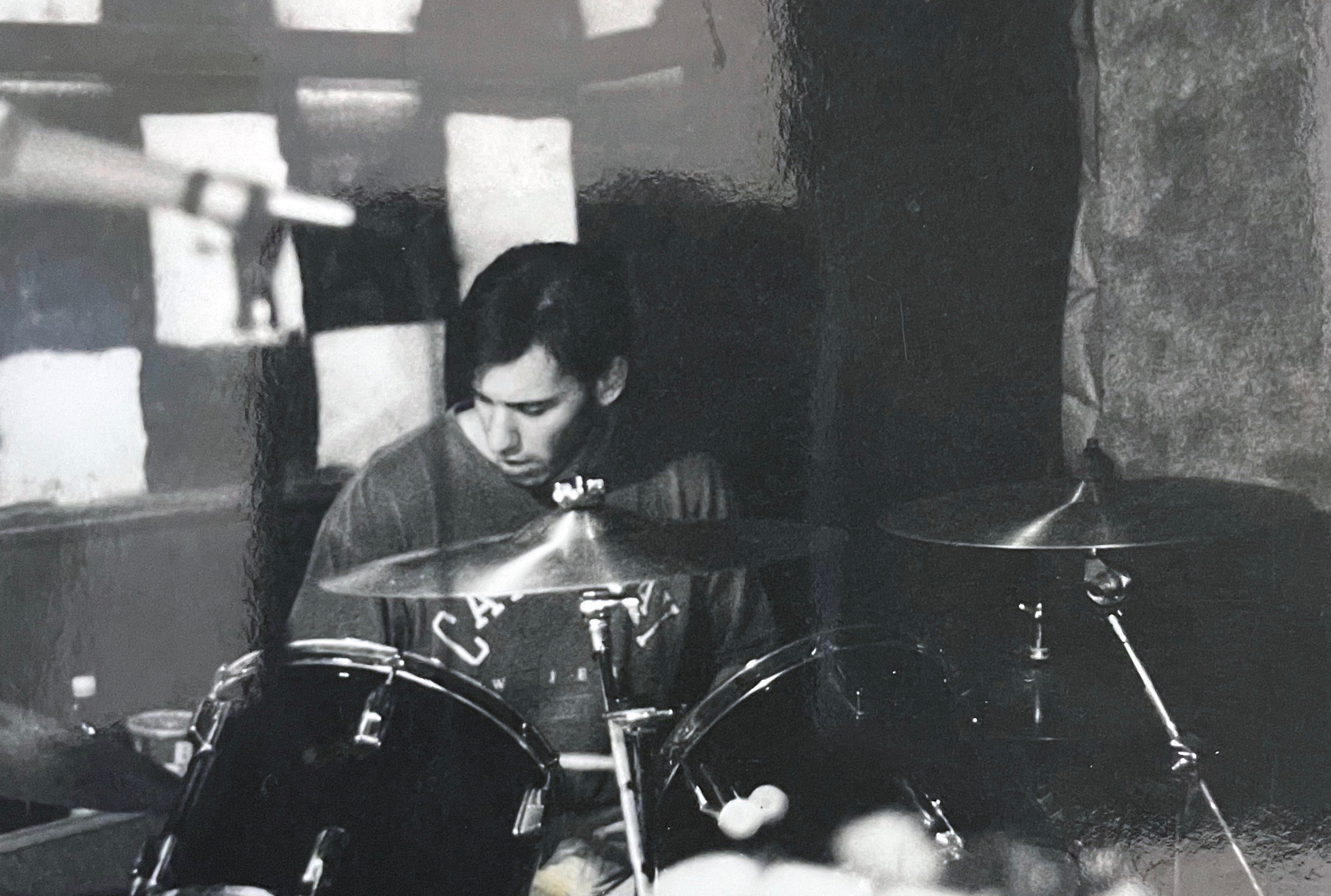Or How to Punk-Rock Drum 4Ever
By James Noll
STEP 1
After months of begging and whining, have your father cave in and promise you a black 1984 Pearl Export starter kit for your 12th birthday. Be down the street playing basketball with your friend Franklin when the delivery truck drives past. Spring home, tear open the boxes, and discover that your new kit comes with shells and cymbal stands but no cymbals. Use the rim of the snare drum as a hi-hat for as long as you can stand it, then do a pre-internet deep-dive into the cymbals preferred by your favorite drummers, Neil Peart and Stewart Copeland. Get your hands on a Zildjian catalog and feel for the first time the terrible pain of the broke-ass drummer.
Ask your parents to drive you to local music stores. See that the prices there are no cheaper. If you’re on the East Coast in the 1980s and live near Springfield, Virginia, suffer the open hostility and arrogance of the bitter aspiring musicians who work at Veneman Music.
Vow to only use catalogs and local music stores to buy sticks and skins and other gear from then on. Carry a grudge against the entire Veneman’s chain to the point that, later in life when you hear that the Springfield outlet has been turned into a check-cashing place, you rejoice.
Mow countless lawns and do odd jobs to save up enough money to buy a pair of 15-inch hi-hats, a 16-inch crash cymbal, and a 20-inch ride cymbal. Discover that crash cymbals tend to crack and have to be constantly replaced, only you’ve already blown the last of your money on the not-so-necessary 20-inch ride. Spend the rest of your life forgetting this lesson and trying to make do with cracked crash cymbals. Decide you can’t live, and definitely can’t properly drum, without rototoms and octobans. Save up and buy them, too.
STEP 2
Play, over and over, the following:
“Tom Sawyer, “Red Barchetta,” “Limelight,” Side 1 of Fly by Night, the entirety of Outlandos d’Amour and Reggatta de Blanc, “Spirits in the Material World,” “Invisible Sun,” “Hungry for You,” Side 2 of 2112, “New World Man,” “The Spirit of Radio,” “Freewill,” and the entirety of Zenyatta Mondatta and Synchronicity. Attempt to play “La Villa Strangiato.” Fail. Keep trying. Get some of it down. Stop playing along with Rush after Grace Under Pressure.
Make sure to start practicing a few minutes before your mother gets home from work, regardless of how hard a day she claims she’s just had. Refuse to stop even when she begs, then orders, then threatens. This will ensure maximum friction and lead to a lifetime of your mother giving you money for your birthday and insisting that you not buy drum stuff with it.
STEP 3
Form a band. Recruit one of your friends to play guitar. Rack your brains to come up with a catchy and cool name—like Glass Tiger, or Wang Chung, or Milli Vanilli.
Go with Crunchy Yellow Cauliflower.
Write some songs. Title them “I Like Mustard” and “Moldy Reindeer.”
Practice in your bedroom for an audience of stuffed animals, a double bed, and a dresser. Temporarily abandon project to focus instead on girls and binge drinking.
STEP 4
Go to college and try again. After three years of annoying roommates, decide that the only way to find real musicians is to work at a restaurant. Avoid chains, especially ones that have possessive food or day of the week nouns in their names. Discover every talented rock musician in town doing what they were born to do: scrubbing dishes, prepping sauces, and slinging beers.
Start a punk band with three of them, then a side project with three others.
Write more original music. Practice once a week in marathon sessions that destroy your GPA. Guzzle too much low-quality beer. Guzzle too much high-quality beer. Play at local bars, basements, and field parties. Understand that this will require carrying all 500 pounds of your gear—four shells, rototoms, octobans, five stands, five cymbals, a throne, and a kick pedal—everywhere in perpetuity. Wonder if bars purposefully build their stages on the second or third floors just to torture you. Sell your roto toms and octobans. Stop using the second rack tom. Cut down your cymbals from five to three.
Develop a small but impressive following as well as lower, middle, and upper back problems. Believe you can grow this following outside of town. Expand touring circuit to regional bars, basements, and field parties. Add the odd small club or squat house. Transport gear and personnel with a variety of inadequate personal vehicles, mainly compact sedans. Pool your money to buy a used conversion van so the entire band can travel together, maximizing interpersonal tension in addition to reminding everyone of the importance of hygiene.
Make sure to plaster the spare tire cover and every inch of the back doors with band stickers, making it easier for a cop, specifically that one in Connecticut, to identify you as malcontents, pull you over, insist he “smells something,” and force you to unload all your gear on the side of the highway, only to find nothing but issue you a citation anyway for following the car in front of you too closely.
Continue to haul your gear—now winnowed down to 450 pounds, including three shells, three stands, three cymbals, a throne, and a kick pedal—up and down multiple flights of increasingly steep and narrow stairs every show you play. Realize your small but impressive local following is made up entirely of friends and the other bands with whom you share a bill.
Make a lot of good musician friends. Meet a lot of weirdos. Discover that some of the latter have ended up being the former, and some of the former have become the latter. Record several indie albums. Release them to no acclaim. Make bad money. Eat bad food. Get bad rest. Start bad habits. Further develop now-chronic lower, middle, and upper back pain. Know that you are too broke to afford a massage or chiropractic care. Gain weight. Experience relationship problems because of your practice and gig schedule and inability to earn any money from playing music.
Discover that you are now in your late 20s and people in your inner musician circle are whispering things behind your back. Hear one say, as if describing a terminal disease, “I’ve heard that if you don’t make it by 30, it’s time to quit.” Know that they’re talking about you.
Vow never to quit.
Turn 30.
Decide that all your efforts have gotten you no closer to a career in music, your back hurts, your ears hurt, and your bank account is telling you that you can’t live like an itinerant minimum-wage worker any longer.
Quit.
STEP 5
But not entirely.
Become a responsible adult. Land a better-paying job and health insurance teaching high school. Enjoy evenings and weekends off. Celebrate holidays without hauling 500 pounds of drums up and down stairs. Get married. Have children. Buy a house. Do things for them. Wake up one day and realize it’s been years since you’ve done much of anything that doesn’t involve job, family, or housework.
Decide you need a hobby. A pursuit. A pastime. Consider joining a bowling league, or binge drinking. Wonder if your old music habit, long dormant, can be reawakened if you buy the right recording equipment. Do it.
Build what you hope will be a soundproof room in a dark corner of your basement. Fill it with all your drums and other instruments. Record music there without any formal studio recording training. Produce a handful of albums, then give up because, while the songwriting might be okay, the sonic quality is subpar. Blame this not on your lack of formal training but on the gear.
Buy more gear.
Produce another handful of albums. Admit that maybe it isn’t the gear that makes the albums you produce less than sonically gratifying after all, but your lack of formal training.
Give up again.
Get a good idea for a song.
Buy more new gear and record it.
Repeat for the next 15 years.
STEP 6
Be in your late 40s during a pandemic and start working from home.
Realize that by an amalgamation of luck and poor personal choices, a few of your musician friends, also working from home, or not working at all, are still in the area and are still playing music.
Get a call from one of those friends to see if you want to restart a punk band you were in 20 years ago because pandemic isolation is driving her stir-crazy.
Know someone who, also due to pandemic stir-craziness, is building a stage in a local warehouse on a busy street near a bend in a road appropriately called Dead Man’s Curve. Decide, based on name alone, that it will be the perfect place for performing with your new/old punk band.
Be ordered back to work but refuse to give up the band just because the pandemic is waning. Include references to your punk-rock drumming and Dead Man’s Curve in conversations with colleagues at the mandatory new employee induction liturgy during the part of the icebreaker introductions when they make you stand up in front of a group of strangers and state your name and something you like to do for fun.
STEP 7
Turn 50. Then 51. Then 52. Record original songs with your band. Sell records to friends and family. Do high-energy shows at the warehouse near Dead Man’s Curve. Take days of rest and Advil to recover, but tell yourself it’s worth it. Buy all the equipment you want but don’t really need. Wonder what your music life would have been if you’d been able to afford all this stuff 30 years ago when you were so desperate for it but so chronically broke.
Live out your adolescent Crunchy Yellow Cauliflower dreams.
Discover that people in your inner musician circle are whispering things behind your back. Hear one say, as if describing a terminal disease, “I’ve heard that once you turn 60, it’s time to quit.”
Know that they’re talking about you.
Don’t listen. Go meta instead. Write a seven-step instruction manual on “How to Punk-Rock Drum 4Ever.”
Get better ear plugs.
And Now
***
James Noll has worked as a sandwich maker, a yogurt dispenser, a day care provider, a video store clerk, a day care provider (again), a summer camp counselor, a waiter, a prep cook, a sandwich maker (again), a line cook, a security guard, a line cook (again), a bartender, a librarian, and a teacher. Somewhere in there he played drums in punk rock bands, recorded several albums, and wrote dozens of short stories and a handful of horror, sci-fi, and post-apocalyptic novels, including Raleigh’s Prep, Tracker’s Travail, Topher’s Ton, The Hive, The Rabbit, The Jaguar & The Snake, and Mungwort. You can check him out online at silverhammer.studio.


